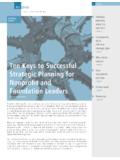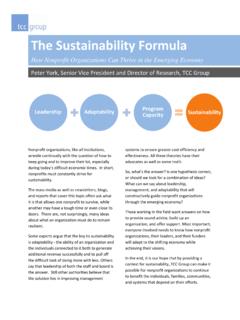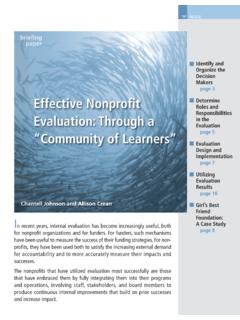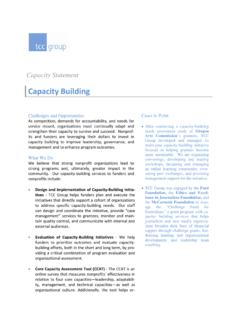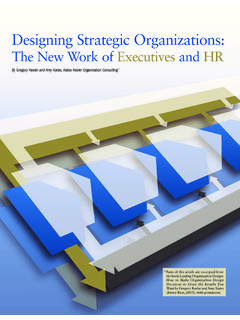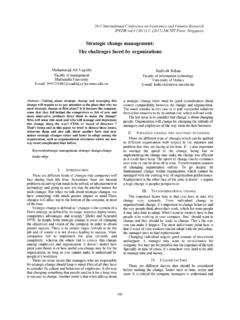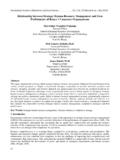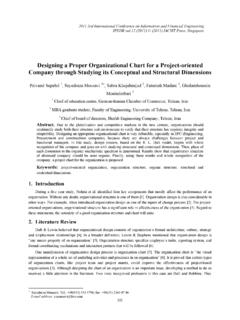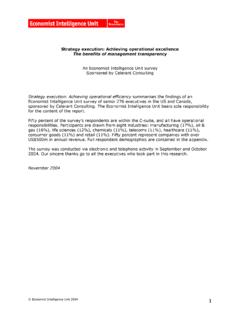Transcription of Funding for Impact: Strategic Grantmaking How to Design ...
1 Shelly KesslerAshley SnowdonHistorically, philanthropic foundations have rarely had to justifythe use of their funds as long as they were being directed to thepublic good. Recently, however, public and private funders havebeen held to a higher standard of impact, both by regulators andthe general public. In response, funders are increasinglyattempting to demonstrate the impact of their Grantmaking . Summative evaluations are helpful in showing what happenedas a result of Grantmaking , but all too often the findings do notinfluence future Funding the program is over, and the donor hasmoved on to new issues or strategies. The most significant wayto increase the effectiveness of a foundation's Grantmaking is tofocus on the first steps in the process: grants program to achieve social impactA Shift TowardStrategicGrantmaking ppage 22 The Six Stepsof the ProgramDesign Process ppage 331) Identify the Issue2) ArticulateAssumptions3) Scan the Field4) Take Stock of YourInternal Capacity5) Validate Your Assumptions6) Implement, Evaluate,and Plan AgainMethods forScanning ppage 88A Final Word ppage 111 Inside: Funding for Impact.
2 How to Design StrategicGrantmaking Programs tccgroupThough most funders spend considerable timethinking about the issues they hope toaddress, they spend inadequate time up frontthinking through the impact they would like tohave with their Grantmaking and how to allo-cate their resources to achieve their goals. Starting a new philanthropic program is bothexcit ing and daunt ing. There are s o manysocial problems to be addressed, and so manypossible ways of addressing them, that thestrategic choices can be overwhelming. Forfunders reviewing and revising existing pro-grams, there are generally more parametersand more knowledge about what has andwhat hasn't worked well. Whether reshapingan existing program or developing a new pro-gram, funders are faced with a similar set ofquestions, including: What criteria can beused to determine which issue is most press-ing?
3 How can you know which grantmakingapproach best lends itself to a particularissue? How do you find those elusive "lever-age points" funders always seem to be talkingabout? Building on TCC Group's twenty-six years ofexperience in Strategic philanthropy, this brief-ing paper is intended to assist grantmakersdesigning new grants programs, as well asthose rethinking existing programs, as theydevelop a focused Funding strategy. The paperprovides a logical process to help guide youthrough the many questions raised whendesigning grant programs. To be clear, Design -ing a grant program is undeniably complex andrequires time and thoughtfulness; there is nosingle "right way" to develop a strong pro-gram. However, by following a series ofthoughtful steps, covering the critical ques-tions and including the appropriate people, youincrease the likelihood that you will develop aneffective program.
4 Several key trends have greatly influenced thefield of philanthropy in the past decade. First,the huge growth in the philanthropic sectorhas made it a more significant part of theeconomy. In 2004, the roughly 66,000 grantmak-ing foundations in the gave a record $ , reversing several years of philanthropicdecline. As such, the sector is increasinglybeing held to higher standards of effective-ness. Second, as Enron and other accountingscandals in the early half of this decade shookthe public's confidence in the private sector,they also brought increased scrutiny of thephilanthropic arena. Allegations of dispropor-tionate administrative costs being counted aspart of a foundation's annual payout, alongwith excessive compensation for executives atsome foundations, created a public outcry forgreater accountability for the charitable dol-lars entrusted to foundation officers.
5 A thirdmajor influence on philanthropy is the increas-ingly difficult Funding environment in whichnonprofits are operating. Declines in govern-ment support of nonprofit organizations, cou-pled with an increase in the number of non-profits, have led to increasing competition forprivate dollars. Faced with a constant demandfor their support, many funders are trying to bemore Strategic with how they use theirresources and are paying more attention toperformance outcomes of their grantees. As aresult of these trends, many grantmakers feelthey must demonstrate that their programsare producing valuable results and that theyare getting the "bang for the buck" out of theirinvestments. 2briefing paperA SShift TToward SStrategic GGrantmakingThough most fundersspend considerabletime thinking aboutthe issues they hopeto address, theyspend inadequatetime up frontthinking through theimpact they wouldlike to have withtheir grantmakingand how to allocatetheir resources toachieve their outcome of these developments isthat we are seeing more grantmakers engag-ing in increasingly complex Funding initiativesand developing programs with broad social-change objectives.
6 These initiatives often arefunded collaboratively, spread across multiplesites, involve many grantees, and last for longperiods of time, thus making it more difficultto identify results. Most important, they areaimed at achieving long-term change ratherthan immediate results, making it even moredif ficult to assess the impact of an the growing expectations for perfor-mance and the complexity of Grantmaking ini-tiatives, funders are paying more attention tothe development of their Grantmaking pro-grams. More and more, funders have come torealize that it is difficult to evaluate the impactof their philanthropic efforts if they have notclearly articulated their Funding strategy andgoals at the outset. A rigorous program designprocess enables funders to achieve the mostimpact with their limited resources.
7 Evaluationcan then inform them of the efficacy of theirapproach by feeding back into the planningprocess and helping funders unders t and whathas worked and what hasn't, so that they canapply that knowledge as they refine grant-making quick review of the literature shows thatthere are a number of "models" for designinggrantmaking programs. We analyzed a num-ber of these models and found that, for themost part, they shared some common ele-ments or steps that seem to define effectivegrantmaking, as shown in the exhibit to theright. The steps are as IIddeennttiiffyy tthhee AArrttiiccuullaattee SSccaann tthhee TTaakkee ssttoocckk ooff yyoouurr iinntteerrnnaall VVaalliiddaattee yyoouurr IImmpplleemmeenntt,, eevvaalluuaattee,, aanndd ppllaann aaggaaiinnThis sixth step is not part of the designprocess but completes the feedback loop thatallows grantmakers to constantly improvetheir steps probably appear quite intuitiveand simple.
8 Indeed, you probably engage in atleast some of them already. You may scan thefield informally on an ongoing basis, conductan internal review as part of the strategicplanning process, or just intuitively factorlessons learned from previous experiencesinto your Funding strategy. From our experience, however, many fundersdo not approach program planning , they ask a few select questions to vali-date their hypotheses, but do not sufficientlyassess the complexities of the issue they areaddressing. By conducting these activities as part of amore structured process, you will develop astronger grants program that is more reflec-tive of the needs of your constituents, bestpractices in the field, your internal values andcapacities, and the external environment.
9 3 The PProgram DDesign PProcessMore and more,funders have come to realize thatit is difficult to evaluate the impactof their philanthropicefforts if they havenot clearly articulatedtheir Funding strategyand goals at the first step to designing a program is toidentify the problem you are attempting tosolve. Often, the issue you choose to focus onis based on internal criteria. These may includea founding philanthropist's stated legacy at aprivate foundation; a corporate philosophy andalignment with business goals at a corporatefoundation; a public mandate; an existinggrants program; or the shared values of foun-dation managers. These parameters may rangefrom the broad outlines of intent to a specificidentification of a subject area. For example,after witnessing underemployment and lan-guage barriers facing Asian newcomers intheir home state of Vermont, the FFrreeeemmaannFFoouunnddaattiioonntruste es were specific in their inter-est in creating economic opportunities nation-ally for Asian refugees and immigrants.
10 Thefoundation s task was to determine how bestto create those opportunities. For the trusteesof the WWaacchhoovviiaa FFoouunnddaattiioonn, whose broad mis-sion is to "build strong and vibrant communi-ties, improve the quality of life, and make apositive difference where we work and live,"identifying the programmatic issues on whichto focus in order to achieve that goal was amore significant challenge. Is improving thequality of life best achieved through medicalresearch or cultural participation efforts, education, or land conservation? Based on itsprevious Grantmaking experience and generalknowledge of the education field, the founda-tion had some preliminary ideas about whatworked and was interested in the idea ofincreasing student achievement by improvingteachers' performance.
